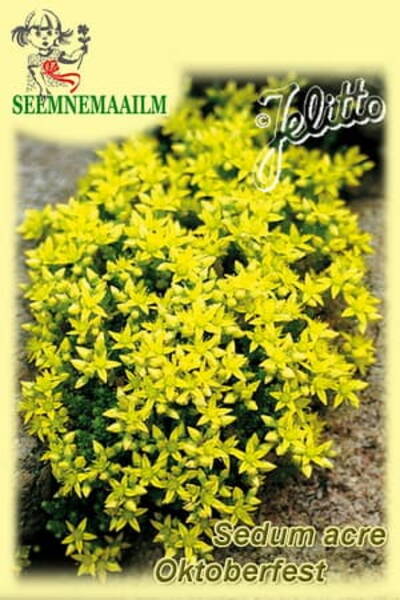Origin: Greenland to the tip of South America.
Special Features: The first creamy-white flowering seed strain of Sedum acre.
History: Introduced by Jelitto in 2005.
Colour: Creamy white.
Natural Flowering Period: June - August.
Winter Hardiness Zones: Z4-8.
Growth Habit: Mat-forming.
Foliage: Dainty, drought-resistant leaves.
Height with Flower: 6 cm.
Spacing between Plants: 30 cm.
Soil Requirement: Well-drained soils; 6.8 - 7.2 pH.
Location: Full sun.
Use: Great rock garden selection for dry sites or in containers.
Specialities: Outstanding, low-growing groundcover.
Cultural Tips: Grams per 1000 seeds: 0,05. Seeds per Gram: 20000.
Seeding Recommendation: 0,25 g /1000 plants.
Sowing Rate: 5 seeds per cell.
Plug tray recommended size: 128 or 288.
Germination: These are very tiny seeds which should be mixed with finest sand or talcum for an even sowing. Do not cover with compost, only press them in gently. Irrigate from the bottom or with a hand-sprayer, so that the seeds will not be washed away. Rapidly germinating, keep seed in constant moisture (not wet) with temperatures of about +20°C. Do not cover the seed but tightly press into the earth. Keep in cooler conditions after germination occurs.
Scheduling.
Best Sowing Dates: Anytime.
Sowing to Germination: 2 - 3 weeks.
Germination to Transplant: 4 - 6 weeks.
Transplanting to Salable Plant: 6 - 8 weeks.
Cutting-Back at Transplanting: Not Necessary.
Growing On: Container Size(s): 1 plug per 8/9 cm; 1-2 plugs per 11/12 cm.
Vernalization: A prudent recommendation would be to provide 6-12 weeks at an average daily temperature of 5°C. Exposure to cold may not be necessary for flowering but might improve quality.
Forcing: An obvious place to experiment - following vernalization - would be raising daytime temperatures to (15° - 17°C). Provide 16 hours of continuous lighting. During the short days of winter, provide a night interruption lighting of 4 hours between 10:00 p.m. and 2:00 a.m. Fertilization: Light (100-150 ppm).

Physical Characteristics An evergreen perennial growing to 0.05m by 0.3m . It is hardy to zone 5 and is not frost tender. It is in leaf all year, in flower from June to July, and the seeds ripen from July to August.
The flowers are hermaphrodite (have both male and female organs) and are pollinated by Bees and flies. The plant is self-fertile. We rate it 1 out of 5 for usefulness.
The plant prefers light (sandy), medium (loamy) and heavy (clay) soils, requires well-drained soil and can grow in nutritionally poor soil. The plant prefers acid, neutral and basic (alkaline) soils. It cannot grow in the shade. It requires dry or moist soil and can tolerate drought. The plant can tolerate maritime exposure. Habitats and Possible Locations In Walls, In South Wall, In East Wall, In West Wall, Ground Cover. Cultivation details A very easily grown plant, it succeeds in most soils but prefers a sunny position in a fertile well-drained soil. Established plants are drought tolerant. Grows well on walls.
Plants can be very aggressive and invasive, spreading freely at the roots. If clearing the plant from an area it is quite important to try and remove every part of the plant since even a small part of the stem, if left in the ground, can form roots and develop into a new plant. All members of this genus are said to have edible leaves, though those species, such as this one, that have yellow flowers can cause stomach upsets if they are eaten in quantity. Plants in this genus seem to be immune to the predations of rabbits.
Propagation Seed - surface sow in spring in well-drained soil in a sunny position in a greenhouse. Do not allow the soil to dry out. It can also be sown in the autumn in a cold frame, some seed germinates immediately whilst others germinate in the spring. Prick out the seedlings into individual pots when they are large enough to handle. If sufficient growth is made, it is possible to plant them out during the summer, otherwise keep them in a cold-frame or greenhouse for their first winter and plant them out in early summer of the following year.
Division is very easy and can be carried out at almost any time in the growing season, though is probably best done in spring or early summer. Larger divisions can be planted out direct into their permanent positions. We have found it best to pot up the smaller divisions and grow them on in a lightly shaded position in a cold frame, planting them out once they are well established in the summer.
Eng.: Goldmoss stonecrop, common stonecrop, wall pepper, biting stonecrop.











